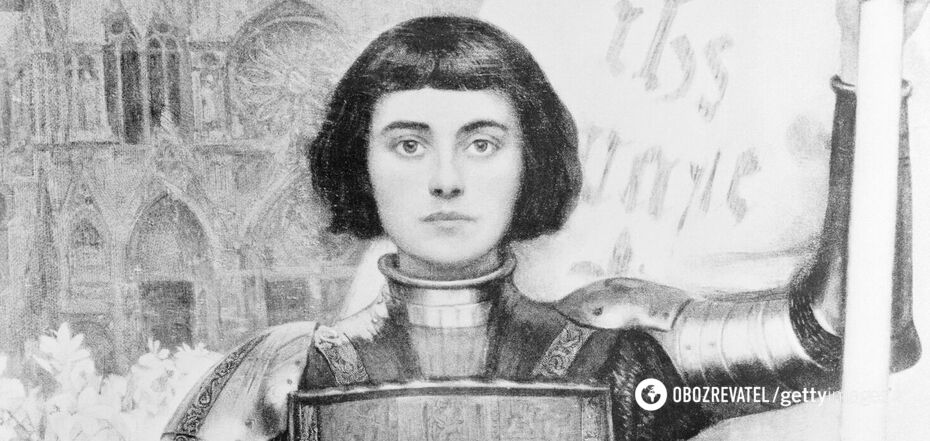Entertainment
She wore men's clothes and started the bob trend. Interesting facts about Joan of Arc that you might not know
Joan of Arc is one of the most famous heroines in history, a widely publicized martyr who was burned at the stake by the Catholic Church on May 30, 1431. During her short life, she managed to save France and gain the "fame" of a witch. But years later, she was acquitted and canonized as the patron saint of France in 1920.
Even today, a few centuries after her death, the name of Joan of Arc remains instantly recognizable not only in France but all over the world. OBOZ.UA has prepared a selection of interesting facts about the life and death of the French national heroine.
Joan of Arc had several different names
The real name she was given at birth remains something of a mystery. In the town of Domremy, where she was born, the woman was known as Jeannette, while other records show that her name changed to Joan of Arc, Jeanne of Tarke, Jeanne of Rome, and Jeanne de Vouton. In preparation for the trial, she mentioned her name as "Jeanne la Pousselle," which translates to "Jeanne, the maid." It is possible that her name was Jeanne Darke or Jeanne Tarke, in honor of her father, as apostrophes were not used in the 15th century.
Joan of Arc was a rebel
She considered herself unlike any other woman of her era. She wore men's clothes that allowed her to lead an army of men in battle and cut her hair short in the signature bob that is associated with French women today. In 1909, the famous hairdresser Monsieur Antoine even claimed that Joan of Arc was his greatest inspiration when he started cutting women's hair into a bob hairstyle.
A witch or a mental patient?
At the trial, Jeanne testified that when she was 13 years old, she began to see visions and hear voices. One of the visions she saw was of the Archangel Michael surrounded by angels, who she said appeared to her in her father's garden. D'Arc said she continued to see visions of St. Michael for the rest of her life, as well as St. Catherine and St. Margaret. Joan claimed that these heavenly voices instructed her to help the French crown recapture territory from the English during the Hundred Years' War. She believed she had a divine mission. However, modern doctors suggest that such incredible visions could have been caused by the presence of one of the mental illnesses that cause hallucinations or delusions, including migraines, bipolar disorder, or brain damage.
Almost died during the battle
Although Joan is remembered as a fearless warrior and considered a heroine of the Hundred Years' War between France and England, she never actually participated in battles or killed an enemy. Joan of Arc was a strategic planner of battles, motivated the military, and led the army. But this did not make her immune to her own injuries. During one intense battle in the trenches, she was struck by an arrow that pierced her between the neck and shoulder. Always a fearless leader, she returned to her duties in the final stages of the battle, witnessing the moment when the British finally retreated, leaving the French with victory.
She helped Charles VII take the throne, but he did not save her from death
Joan of Arc convinced Prince Charles of Valois to allow her to bravely lead the French army to Orleans in 1429, where she won a triumphant victory over England when she was only 19 years old. During the coronation of Charles VII, Joan stood near the king with a flag in her hands. However, after a while, the king's entourage began to frighten him that Joan would take power from him. And when Joan was taken prisoner by the Burgundians near the city of Compiègne, and they sold her to the British, Charles did nothing to free her. French King VII was not too convinced by her claims of visions and did not try to negotiate her freedom, leaving her to her fate. Jeanne spent many months in prison. She was kept in an iron cage, with chains around her neck and legs. In order to denigrate her in the eyes of the French, she was accused of having a connection with the devil. She was judged by French bishops who sided with the English. In May 1431, Joan was burned alive in the central square of Rouen.
Only 25 years later, before his death, King Charles VII dropped all charges against Joan of Arc. If the verdict had remained in force, it would have meant that Charles owed his crown to the sorceress.
Today, Joan of Arc is a national heroine of France
Today, the French consider Joan of Arc to be their national heroine, as she was a key figure in helping to unite the country and expel foreign troops. Her deeds became a symbol of willpower and patriotism, which helped shape the French national identity. Her memory is honored annually in France, in particular in her homeland of Domremy and in Orleans, where she played a key role in lifting the siege.
The image of the savior of France is a symbol of the revival of national consciousness and is not associated with blood and murder, as Joan of Arc was primarily an inspirational figure, not a soldier. Her fate has not left indifferent many generations of artists who have dedicated their works to her. Famous playwrights such as William Shakespeare and George Bernard Shaw have written about her, and she has been depicted in countless works of art as a symbol of heroism, faith, and national pride. Her story continues to inspire artists and writers to this day, ensuring that her legacy is preserved through a variety of artistic expressions.
Only verified information is available on the OBOZ.UA Telegram channel and Viber. Do not fall for fakes!





























